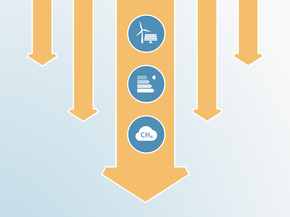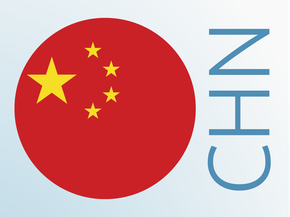Assumptions
Historical emissions
Historical emissions are based on the 1990-2022 inventory emissions developed by the US Environmental Protection Agency (EPA) (U.S. Environmental Protection Agency, 2024g). The national inventory was reported in AR5 Global Warming Potential (GWP) values. The EPA has not released an updated inventory since the Trump Administration assumed office in 2025. In September 2025, the EPA proposed to end its Greenhouse Gas Reporting Program (GHGRP), which requires energy and industrial facilities to track and report their direct GHG emissions; data which has been critical for the development of the EPA’s annual emissions inventory (Congressional Research Service, 2023; U.S. Environmental Protection Agency, 2025a).
NDC and other targets
Voided 2030 and 2035 NDC targets
For the 2030 NDC target, we apply the indicated target of 50%–52% reduction to the 2005 base year including LULUCF and then subtract the projected emissions for the LULUCF sector. The LULUCF emission projections in 2030 were taken from the 5th Biennial Report which reported sinks of 0.6–0.8 GtCO2e/year in 2030 (U.S. Department of State, 2022).
For the 2035 NDC target, we apply the indicated target of 61%-66% reduction to the 2005 base year including LULUCF and then subtract the projected emissions from the LULUCF sector, The LULUCF emission projections in 2030 were taken from the 5th Biennial Report which reported sinks of 0.6–0.9 GtCO2e/year in 2035 (U.S. Department of State, 2022).
Voided 2050 net zero target
For the net zero target, we assume total GHG emissions in 2050 are balanced by projected sinks in 2050. The LULUCF sinks in 2050 were taken from the US long-term strategy (LTS) submitted to the UNFCCC in November 2021 (U.S. Department of State, 2021). Since the document does not provide exact figures, we have extracted the approximated figures from the graphs in the report. The reading of the graphs results in an approximation of minus 0.6-1.4 GtCO2e for LULUCF sinks in 2050, we add this sink to the residual estimate in 2050 to get 0.6-1.5 GtCO2e in 2050. We include also estimates for 2040 in our pathway using a similar approach.
Current policy scenario projections
The CAT developed its own policy projections for the US and aggregates a range of emissions projections from external studies. The independently quantified current policy projections, which inform the CAT’s rating of the US’ policies and actions, are based on projections from the US Energy Information Agency (EIA) and the US Environmental Protection Agency (EPA). In some sectors, the projections are adjusted through external studies. The range of emissions projections from external studies creates the minimum and maximum bounds for the emissions projections. The quantification approach is outlined in more detail below.
The CAT’s independently quantified current policy projections were generated in four steps:
- First, we estimate the total emissions projections under current policies as the aggregation of the energy, industry, agriculture, and waste sectors:
- GHG emissions in the energy sector:
- Energy-related CO2 emissions projections: short-term projections (2023–2025) were taken from the EIA Short-term Outlook from August 2025 (U.S. Energy Information Administration, 2025b). These projections are harmonised with long-term projections (2024–2035) taken from the EIA’s 2025 Annual Energy Outlook (AEO) High Oil and Gas Supply scenario (U.S. Energy Information Administration, 2025a).
- The 2025 AEO High Oil and Gas Supply scenario features a significant slowdown in renewable energy capacity additions through 2035 in comparison to the 2025 AEO Reference Case, which considers all major policies and action implemented by the end of 2024. The decrease in cumulative renewable energy capacity additions mirrors the impact of the OBBB's termination and restrictions on the IRA's Clean Electricity Production Credit and Clean Electricity Investment Credit. The scenario projects that cumulative solar and wind (on- and offshore) capacity additions amount to approximately 350 GW by 2035.
- CH4 and N2O emissions in the energy sector from EPA's 2025 Global Non-CO2 Greenhouse Gas Emission Projections & Mitigation Potential: 2020-2080 (U.S. Environmental Protection Agency, 2025b). Converted all values from AR4 GWPs to AR5 GWPs using the GWP conversion factor from the International Energy Agency (IEA) (IEA, 2023).
- All GHGs emissions in the energy sector result from the sum of the CO2 and non-CO2 estimates as described above. The resulting projections are harmonised to the latest historical year using growth rates.
- GHG emissions in the industry sector: the projection of GHG emissions in industrial processes was calculated by type of industry and then aggregated.
- Emissions from mineral, chemical, and metal industries were projected by applying projected production growth of each industry in terms of value of shipments taken from the High Oil and Gas scenario in EIA 2023 AEO (2022-2023) nd 2025 AEO (2024-2035) (U.S. Energy Information Administration, 2023a, 2025a).
- Emissions from remaining industries were projected by using the growth rates for fluorinated gases from the EPA's 2025 Global Non-CO2 Greenhouse Gas Emission Projections & Mitigation Potential: 2020-2080 to forecast emissions from 2023-2035 (U.S. Environmental Protection Agency, 2025b). Converted all values from AR4 GWPs to AR5 GWPs using the weighted GWP conversion factor for fluorinated gases.
- GHG emissions in the agriculture sector:
- CH4 and N2O emissions projected by using growth rates from the EPA's 2025 Global Non-CO2 Greenhouse Gas Emission Projections & Mitigation Potential: 2020-2080 to forecast emissions from 2023-2035 (U.S. Environmental Protection Agency, 2025b). Converted all values from AR4 GWPs to AR5 GWPs using the GWP conversion factor from the IEA (IEA, 2023).
- GHG emissions in the waste sector:
- CH4 and N2O emissions projected by using growth rates from the EPA's 2025 Global Non-CO2 Greenhouse Gas Emission Projections & Mitigation Potential: 2020-2080 to forecast emissions from 2023-2035 (U.S. Environmental Protection Agency, 2025b). Converted all values from AR4 GWPs to AR5 GWPs using the GWP conversion factor from the IEA (IEA, 2023).
- GHG emissions in the energy sector:
- Second, each of the above emissions categories were harmonised to historical data for each sector by applying the estimated annual percentage change from the projected dataset to the base year. The projections for all sectors were then aggregated to obtain total GHG emissions, excluding LULUCF. These projections are the baseline scenarios.
- Third, the quantification of the One Big Beautiful Bill Act’s (OBBB) impact on non-CO2 GHG emissions:
- The OBBB’s interventions in the energy, industry, agriculture, and waste sectors will increase non-CO2 GHG emissions. To account for the increase in non-CO2 emissions, we used projections from Princeton University’s REPEAT Project (REPEAT) (Jenkins et al., 2025).
- Determined the percent change between the non-CO2 emissions projections from REPEAT’s “Biden-Era Mid Range” scenario (which assumes the continuation of the Biden Administration’s climate policy package until 2035) and the “OBBB Final” scenario.
- Applied the percent change to the combined, economy-wide non-CO2 emissions projections for the energy, industry, agriculture, and waste sectors (described above) and then calculated the absolute difference between the economy-wide non-CO2 emissions projections and the post-OBBB non-CO2 emissions projections.
- Conservatively delayed the OBBB’s impact on emissions until 2026. As a result of the OBBB, non-CO2 emissions increase by 115 MTCO2e in 2030 and 71 MTCO2e in 2035.
- Fourth, the quantification of the OBBB’s impact on direct and indirect CO2 emissions from light-duty vehicle fleet:
- The OBBB will decrease the number of electric vehicles (EVs) in the overall light-duty vehicle (LDV) fleet, while increasing the number of internal combustion engine (ICE) vehicles. The increased number of ICE vehicles will result in increased direct CO2 emissions from the LDV fleet. The direct increase in CO2 emissions from fewer EVs will be partially offset by decreased emissions from the power sector due to decreased electricity consumption by EVs. To capture the increase in direction emissions, we use REPEAT’s projections for the share of EVs, PHEVs, and ICE vehicles in the LDV stock (Jenkins et al., 2025).
- Direct CO2 emissions: Used REPEAT's “OBBB Final” scenario includes projections for the LDV stock makeup until 2030. Harmonized REPEAT's ICE and PHEV LDV stock projections from REPEAT’s “OBBB - Final” scenario to the 2025 AEO High Oil and Gas Supply stock projections (U.S. Energy Information Administration, 2025a). Calculated the average emissions factor for ICE and PHEV LDVs is calculated using the AEO High Oil and Gas Supply scenario. The emissions factor and ICE and PHEV stock data are used to estimate direct additional CO2 emissions.
- Indirect CO2 emissions: Used AEO High Oil and Gas Supply data to determine annual avoided electric LDV mileage and average electric LDV efficiency. Calculated total avoided electricity consumption from electric LDVs based on total avoided electric LDV data and average electric LDV efficiency. We assumed that the avoided electricity consumption results in avoided gas-fired power generation but no impact on power generation from other sources. Used CO2 emissions factor for natural gas generation and total avoided electric LDV energy consumption to calculate avoided indirect emissions.
- Considering both direct and indirect CO2 emissions, the OBBB will increase annual emissions by 11 MtCO2e in 2030 and by 54 MtCO2e in 2035.
The CAT’s literature-derived emissions projections range:
- The range is informed by the total GHG emissions projections by two external studies: Princeton University’s REPEAT Project (REPEAT) and Rhodium Group (Jenkins et al., 2025; King et al., 2025). Both studies quantify the emissions impact of the OBBB and major executive actions (including executive orders on energy and climate, as well as proposed and implemented rule changes at federal agencies). To be consistent with the CAT, we subtracted LULUCF emissions from both studies based on REPEAT’s projections for land carbon sink emissions under their “OBBB - Final” scenario.
- The minimum bound of the emissions projections range is derived from Rhodium Group’s “OBBB Low” scenario (King et al., 2025). The scenario only provides emissions projections for 2035. Performed linear interpolation of the emissions reduction potential for intermediate years from 2025 through 2035. For projections from 2023 to 2024, used the CAT’s independently quantified emissions projections as described above.
- The maximum bound of the emissions projections range is derived from REPEAT’s “OBBB - Final” scenario (Jenkins et al., 2025). The scenario provides emissions projections for 2027, 2030, 2033, and 2035. Performed linear interpolation of the emissions reduction potential for intermediate years. For projections from 2023 to 2024, used the CAT’s independently quantified emissions projections as described above.
Further analysis
Latest publications
Stay informed
Subscribe to our newsletter




